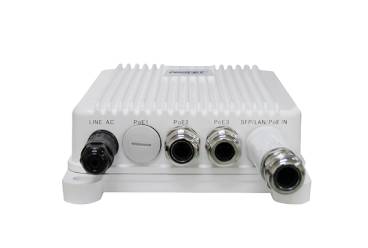It has been more than ten years since PoE switches came out. We all know that PoE switches play an important role in monitoring engineering, especially wireless monitoring. But in the actual application process, it is easy to encounter some problems. In view of this situation, we should consider the considerations of some PoE switches before construction to reduce the maintenance of subsequent projects. Here are some common problems of PoE switches in monitoring projects.
1. Power supply distance of PoE switch
The PoE power supply distance is determined by the data signal and the transmission distance, and the data signal transmission distance is determined by the network cable.
1. Network cable requirements
The lower the impedance of the network cable, the farther the transmission distance, so, first of all, to ensure the quality of the network cable, buy genuine products, it is recommended to use super five types of network cables (the outer skin is marked with "CAT5e"), the transmission distance of the common type 5 data signal is about 100 meters about.
There are two types of PoE standards: IEEE802.af and IEEE802.3at standards. They have different requirements for Cat5e cables, and the difference is mainly reflected in the equivalent impedance. For example, a 100m super Cat5 cable, the equivalent impedance of IEEE802.3at must be less than 12.5 ohms, and IEEE802.3af must be less than 20 ohms. It can be seen that the smaller the equivalent resistance is, the longer the transmission distance is.
2. PoE standard
To ensure the transmission distance of the waterproof PoE Switch, it depends on the output voltage of the PoE power supply. It should be as high as possible within the standard (44-57VDC). The output voltage of the PoE switch port must meet the IEEE802.3af / at standard.
Second, the hidden dangers of non-standard PoE switches
Non-standard PoE power supply is relative to standard PoE power supply. It does not have a PoE control chip and does not detect this step. No matter whether the IP terminal supports PoE or not, it will supply power to it. Burn down the network port.
1. Choose less "non-standard" PoE
When choosing a PoE Switch for base stations, try to choose the standard as much as possible, which has the following advantages:
The power supply terminal (PSE) and the power receiving terminal (PD) can dynamically sense and adjust the power supply voltage.
Effectively protect the power receiving terminal (usually IPC) from being burned by electric shock (other aspects include short circuit and surge protection, etc.)
It can intelligently detect whether the terminal supports PoE, and will not supply power when accessing a non-PoE terminal.
Non-standard PoE switches usually have the above security measures in order to save costs, so there are certain security risks. However, it is not necessary to use non-standard PoE. When the non-standard PoE voltage matches the voltage of the powered device, it can also be used and can reduce costs.

Poe Switches
2. No "fake" PoE
The fake PoE device only merges the DC power into the network cable through a PoE combiner. It cannot be powered by a standard PoE switch, otherwise the device will burn out, so do not use the fake PoE device. In engineering applications, not only standard PoE switches but also standard PoE terminals should be selected.
Three, PoE switch cascading problem
The number of cascaded PoE switches involves the calculation of bandwidth. A simple example:
If a switch using a 100Mbps network port is cascaded to the center, the effective bandwidth is 45Mbps (bandwidth utilization ≈ 45%). If each switch is connected to a monitoring device with a total code rate of 15M, that is 15M of the bandwidth of a single switch 45 / 15≈3, 3 switches can be cascaded.
Why is the bandwidth utilization equal to 45%? The actual Ethernet IP packet header accounts for about 25% of the total traffic, the actual available link bandwidth is 75%, and the actual application considers to reserve 30% of the bandwidth, so the insurance estimates the bandwidth utilization 45%.
Four, PoE switch port identification
1. Access and upstream ports
The ports of the PoE switch are divided into access and upstream, in order to better differentiate services and simplify maintenance, thereby defining different port roles.
Access port: As the name implies, it is the interface directly connected to the terminal (IPC, wireless AP, PC, etc.)
Upstream port: a port connected to the aggregation or core network, usually with a higher interface rate and not supporting PoE.
2. PoE switch
PoE switches include ordinary access ports and upstream ports. Among them, the ordinary access port supports PoE function, and the upstream port has ordinary RJ45 port and SFP optical port.
V. How to configure PoE switch for the device
There are two power supply standards for PoE switches, IEEE802.3af, and IEEE802.3at. The most common camera power on the market is 7W, just use a standard PoE switch. If the camera exceeds 16W, you need to use at standard PoE switch. If the camera power is above 30W, you need to use a dedicated PoE power supply module for power supply.
In addition, it also depends on the total power of the PoE switch. For example, the high-end brand GN9000-4212THM-D PoE switch, 1 ~ 4 ports support PoE power supply, support of/at standard, total power 60W, to meet the market's mainstream camera power supply requirements, in addition, can provide a maximum power supply distance of 250 meters Kinds of working modes.
Under the IEEE802.3af standard, it can supply four ports (60 / 15.4 = 4), that is, it can supply power to four cameras at the same time, that is, full load power supply. If it is calculated according to the IEEE802.3at standard single-port maximum power supply 30W, at the same time, it can only supply power to 2 ports at most (60/30 = 2).
Generally, support PoE switch of af / at standard at the same time, its power supply power is adaptive.